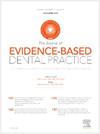臼齿拔牙部位的牙槽嵴保存:一项系统回顾和荟萃分析
IF 4
4区 医学
Q1 DENTISTRY, ORAL SURGERY & MEDICINE
引用次数: 0
摘要
背景磨牙区牙槽嵴保存(ARP)可以有效减少牙槽嵴吸收,促进种植治疗。本系统综述的目的是通过荟萃分析来评估在磨牙拔牙部位进行ARP手术与自然愈合的结果。材料和方法检索PubMed、Embase、Web of Science、Cochrane Central Register of Controlled Trials和System for Information on Grey Literature在欧洲发表的研究。主要结果是牙槽嵴宽度和高度的变化。次要结果包括鼻窦通气和在植入时需要额外的增强。结果共纳入7项研究,包括4项随机对照试验(RCTs)、2项前瞻性非随机临床试验和1项前瞻性病例对照研究。他们共涉及236名参与者的237个臼齿拔牙槽。综述显示,ARP导致显著降低水平变化{平均差(MD) = 2.21毫米,95%可信区间(CI)[0.02, 4.39]},垂直mid-buccal变化(MD = 1.34 mm, 95%可信区间[0.85,1.83]),和垂直mid-lingual变化(MD = 0.96 mm, 95%可信区间[0.54,1.38])相比,自然愈合。脊宽度改变两组之间的差异没有统计学意义(MD = 1.94 mm, 95%可信区间[-1.67,5.55],P = 29)和异质性(I2 = 92%,P & lt; 措施)当限于相关。与单独拔牙相比,ARP减少了种植体放置期间额外增强的必要性(风险比:0.41;95% CI: 0.26 ~ 0.65;P & lt; 措施)。结论sarp可有效减少窝骨和牙槽骨的改变,减少对磨牙区额外隆牙的需要。还需要进一步设计良好、样本量更大、随访时间更长的多中心随机对照研究来进一步证实本综述的发现。本文章由计算机程序翻译,如有差异,请以英文原文为准。
ALVEOLAR RIDGE PRESERVATION AT MOLAR EXTRACTION SITES: A SYSTEMATIC REVIEW AND META-ANALYSIS
Background
Alveolar ridge preservation (ARP) in molar areas might be effective in minimizing ridge resorption and facilitated implant treatment. The purpose of the systematic review was to evaluate the outcomes of the ARP procedure at molar extraction sites in comparison to spontaneous healing through meta-analysis.
Material and methods
Studies published in PubMed, Embase, Web of Science, Cochrane Central Register of Controlled Trials, and the System for Information on Grey Literature in Europe were searched. Primary outcomes were changes in alveolar ridge width and height. Secondary outcomes included sinus pneumatization and need for additional augmentation at the time of implant placement.
Results
A total of 7 studies composing of 4 randomized controlled trials (RCTs), 2 prospective non-randomized clinical trials, and 1 prospective case control study were included. They involved a total of 237 molar extraction sockets from 236 participants. This review revealed that ARP resulted in statistically significant reductions for horizontal changes {mean difference (MD) = 2.21 mm, 95% confidence interval (CI) [0.02, 4.39]}, vertical mid-buccal changes (MD = 1.34 mm, 95% CI [0.85, 1.83]), and vertical mid-lingual changes (MD = 0.96 mm, 95% CI [0.54, 1.38]) when compared with spontaneous healing. The difference in ridge width changes between the two groups was not statistically significant (MD = 1.94 mm, 95% CI [-1.67, 5.55], P = .29) and with substantial heterogeneity (I2 = 92%, P < .001) when restricted to RCTs. ARP decreased the necessity for additional augmentation during implant placement in comparison to extraction alone (Risk ratio: 0.41; 95% CI: 0.26 to 0.65; P < .001).
Conclusions
ARP is efficacious in reducing socket bone and ridge changes, and minimizing the need for additional augmentation procedures in the molar region. Further well-designed multicenter randomized controlled studies with larger sample size and longer follow-up periods are still needed to further confirm the findings of the current review.
求助全文
通过发布文献求助,成功后即可免费获取论文全文。
去求助
来源期刊

Journal of Evidence-Based Dental Practice
DENTISTRY, ORAL SURGERY & MEDICINE-
CiteScore
6.00
自引率
16.70%
发文量
105
审稿时长
28 days
期刊介绍:
The Journal of Evidence-Based Dental Practice presents timely original articles, as well as reviews of articles on the results and outcomes of clinical procedures and treatment. The Journal advocates the use or rejection of a procedure based on solid, clinical evidence found in literature. The Journal''s dynamic operating principles are explicitness in process and objectives, publication of the highest-quality reviews and original articles, and an emphasis on objectivity.
 求助内容:
求助内容: 应助结果提醒方式:
应助结果提醒方式:


